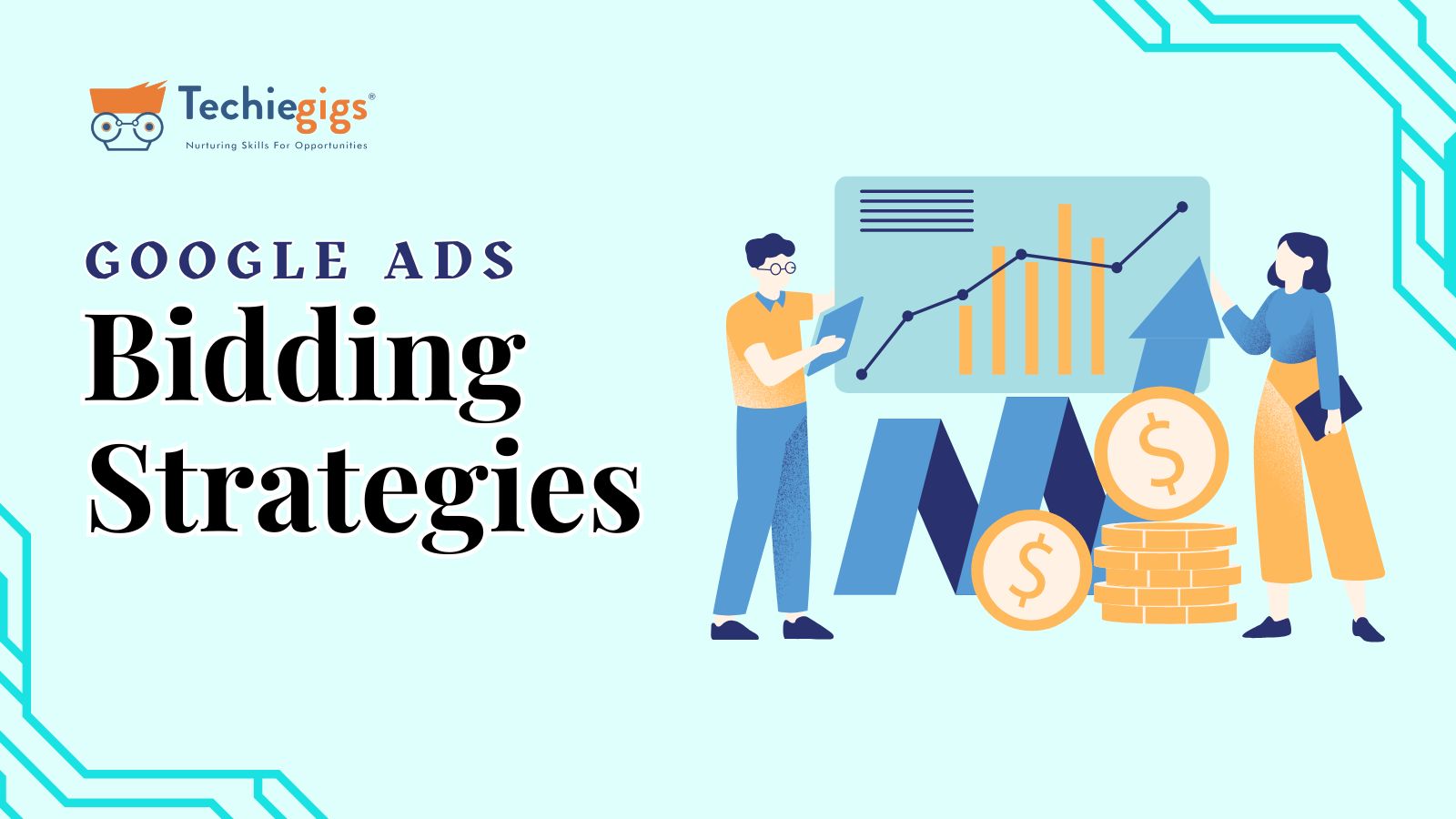A Comprehensive Guide to Bidding Strategies in Google Ads
Google Ads is one of the most powerful digital advertising platforms available today, enabling businesses to reach their target audience effectively. However, to maximize success, selecting the right bidding strategy in Google Ads is crucial. The bidding strategy you choose determines how much you pay for each click, impression, or conversion, ultimately impacting your campaign’s performance and return on investment (ROI).
This blog post will explore different bidding strategies in Google Ads, their advantages, disadvantages, and best-use scenarios to help you make informed decisions and optimize your ad spend.
Table of Content
Understanding Bidding Strategies in Google Ads
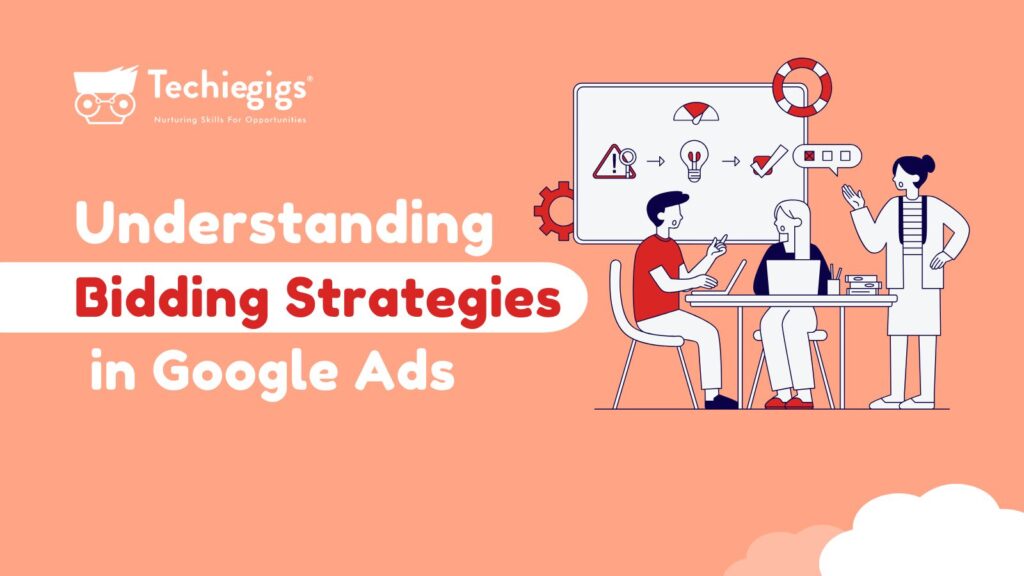
Before diving into the types of bidding strategies, it’s essential to understand how bidding works in Google Ads. When users search for keywords related to your business, Google runs an auction to determine which ads appear and in what order. Your bidding strategies in Google Ads determines how much you’re willing to pay to win these auctions and how efficiently your budget is used.
Google Ads offers both manual and automated bidding strategies. Manual bidding provides greater control, while automated bidding relies on Google’s machine learning to optimize bids for desired results. Let’s explore these in detail.
Types of Bidding Strategy in Google Ads
1. Manual Bidding Strategies
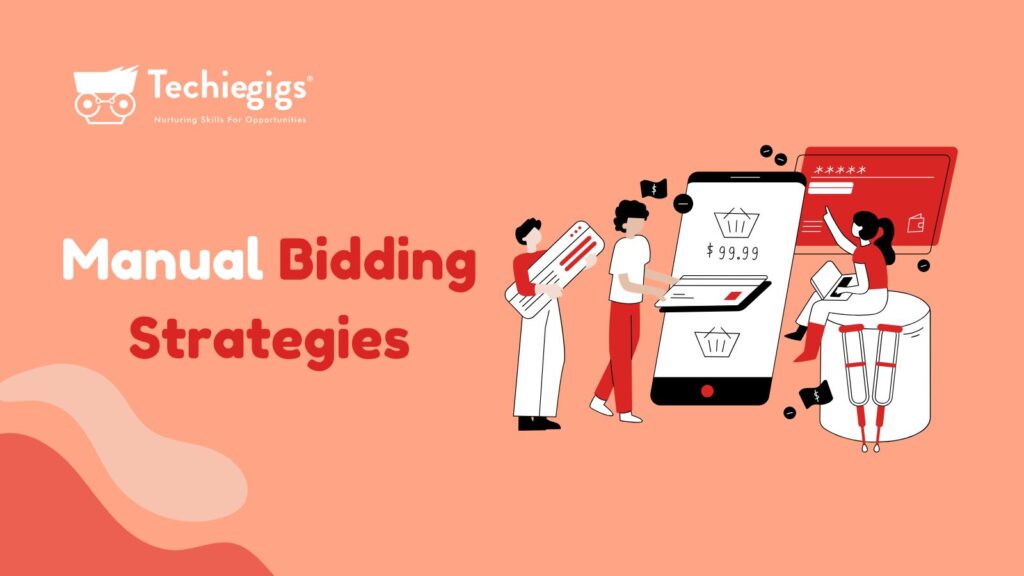
i) Manual CPC (Cost-Per-Click) Bidding
With Manual CPC bidding, advertisers set the maximum cost per click they are willing to pay for an ad. This strategy is ideal for businesses that want complete control over their ad spend and bid amounts.
How It Works: Advertisers manually adjust bids for individual keywords, ad groups, or placements. Google will never exceed the max CPC limit, ensuring cost control. Advertisers can monitor and tweak bids based on performance data and competition trends.
Pros:
- Full control over CPC.
- Allows budget allocation for high-performing keywords.
- Prevents unnecessary overspending.
- Enables advertisers to focus spending on keywords that convert well.
- Allows for bid adjustments based on specific business goals and seasonality.
Cons:
- Requires constant monitoring.
- May not maximize conversions as effectively as automated strategies.
- Time-consuming and requires expertise in bid management.
- Can be inefficient if not optimized frequently.
Best for:
- Advertisers with a limited budget who want precise control over spending.
- Businesses testing different ad creatives before scaling.
- Campaigns focusing on specific high-value keywords where precise bid adjustments are required.
- Advertisers with strong analytical skills who can optimize bids manually.
ii) Manual CPM (Cost-Per-Thousand Impressions) Bidding
With Manual CPM bidding, advertisers pay for every 1,000 impressions rather than clicks. This strategy is primarily used in display and video advertising to increase brand awareness.
How It Works: Advertisers set a maximum bid for every 1,000 impressions. Google prioritizes ads with the highest CPM bids and displays them accordingly. The focus is on visibility rather than direct conversions.
Pros:
- Increases brand awareness by maximizing visibility.
- Ensures advertisers control their ad placement frequency.
- Ideal for businesses focusing on exposure rather than direct clicks.
- Works well for display and video campaigns where engagement matters more than clicks.
Cons:
- May not drive direct conversions or website visits.
- Requires careful monitoring to avoid excessive spending without results.
- Less efficient for performance-driven campaigns focused on immediate ROI.
Best for:
- Brand awareness campaigns targeting a broad audience.
- Display and video ad campaigns where visibility matters.
- Businesses aiming to dominate SERPs in their niche.
- Advertisers focusing on top-of-funnel marketing strategies.
iii) Manual CPV (Cost-Per-View) Bidding
Manual CPV bidding is used for video ads, where advertisers pay based on the number of views or interactions with the ad (such as clicking a call-to-action overlay).
How It Works: Advertisers set a max CPV bid. A view is counted when a user watches 30 seconds (or the entire video if shorter) or interacts with the ad.
Pros:
- Ensures advertisers only pay for engaged viewers.
- Effective for storytelling and brand recall.
- Provides control over cost per view.
Cons:
- Requires high-quality video content to maintain viewer engagement.
- May not generate direct conversions.
- Requires careful targeting to ensure the right audience sees the ad.
Best for:
- Video marketing campaigns focusing on engagement.
- Brand awareness efforts using YouTube Ads.
- Advertisers looking to test video ad performance before scaling.
2. Automated Bidding Strategies
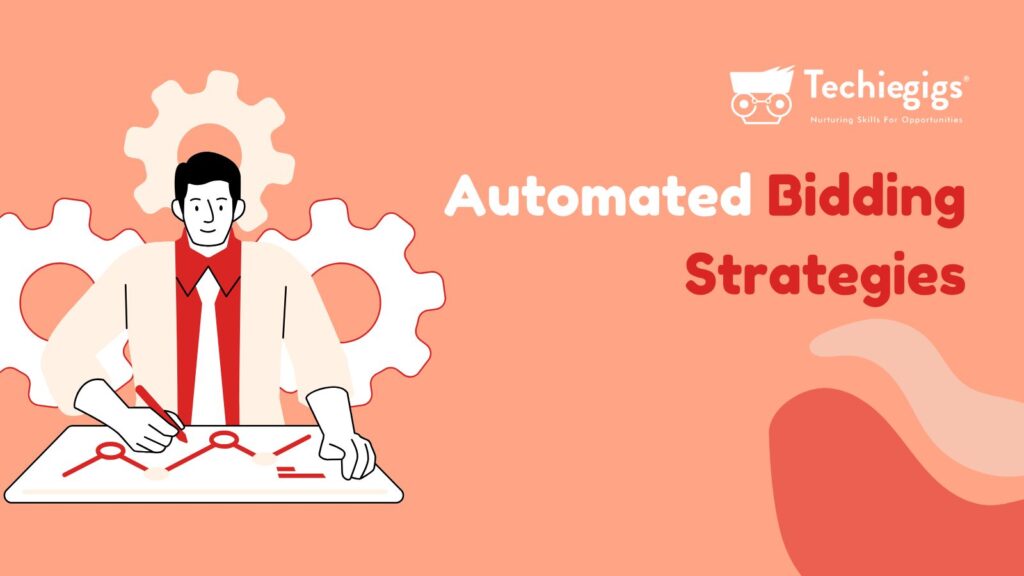
i) Maximize Clicks
The Maximize Clicks strategy automatically adjusts bids to generate the most clicks within a given budget. It is beneficial for businesses looking to drive high traffic to their website.
How It Works: Google Ads automatically increases or decreases bids in real-time based on search trends and competition to maximize the number of clicks.
Pros:
- Helps get the highest possible number of clicks within the budget.
- Reduces manual bid management.
- Optimizes for maximum reach with minimal effort.
- Useful for campaigns focused on driving traffic.
Cons:
- May not focus on conversion quality.
- Can exhaust the budget quickly without guaranteeing conversions.
- Not ideal for lead generation or e-commerce campaigns that require conversions over traffic.
Best for:
- Increasing brand awareness.
- Driving traffic to new landing pages.
- Testing audience engagement with new ad creatives.
ii) Target CPA (Cost-Per-Acquisition)
The Target CPA strategy sets bids to achieve a specific cost per conversion. Google Ads uses historical data and machine learning to adjust bids and maximize conversions within the target CPA.
How It Works: Google Ads automatically adjusts bids to acquire conversions at a predefined cost, using machine learning to predict the likelihood of a conversion occurring.
Pros:
- Helps control acquisition costs.
- Automates bid optimization for conversions.
- Maximizes efficiency for cost-conscious advertisers.
- Uses historical data to refine bidding strategies over time.
Cons:
- Requires sufficient conversion data to function effectively.
- May fluctuate in performance depending on market competition.
- Could miss out on some high-value conversions due to strict CPA limits.
Best for:
- Businesses focused on lead generation.
- E-commerce stores with well-defined conversion values.
- Advertisers optimizing for measurable sales or sign-ups.
iii) Target ROAS (Return on Ad Spend)
Target ROAS is a bidding strategy in Google Ads that optimizes bids based on expected return on ad spend. It ensures that ads generate a specific revenue in relation to the amount spent.
How It Works: Google Ads adjusts bids dynamically to reach the advertiser’s target return on ad spend by focusing on the most valuable conversions.
Pros:
- Maximizes profitability by focusing on high-value conversions.
- Ensures ad spend is directly tied to revenue generation.
- Uses predictive analytics to adjust bids dynamically.
Cons:
- Requires accurate tracking of conversion values.
- May lead to limited reach if the target ROAS is set too aggressively.
- Can be difficult to achieve in low-margin industries.
Best for:
- E-commerce businesses measuring revenue per transaction.
- Companies selling products with varied price points and profit margins.
- Advertisers needing a balance between cost efficiency and revenue generation.
iv) Maximize Conversions
The Maximize Conversions strategy automatically sets bids to get the most conversions within the budget. It is ideal for businesses that want to scale their conversion volume quickly.
How It Works: Google Ads optimizes bids using machine learning to drive the highest number of conversions possible within the campaign’s budget.
Pros:
- Fully automated bid adjustments optimize for maximum conversion volume.
- Uses historical campaign data to identify the best bidding opportunities.
- Efficient use of the campaign budget to maximize results.
Cons:
- Can drive conversions at higher-than-expected CPA.
- Requires historical conversion data for optimal performance.
- No control over individual keyword bid amounts.
Best for:
- Campaigns with a predefined budget aimed at boosting conversions.
- Businesses focused on acquiring new leads or sales at scale.
v) Target Impression Share
The Target Impression Share strategy ensures that ads appear at the top of search results or a specified percentage of the time.
How It Works: Advertisers set a target percentage for impression share (e.g., 90%) and specify where they want their ads to appear—at the absolute top, on the top of the page, or anywhere on the page. Google Ads then adjusts bids dynamically to achieve this goal.
Pros:
- Increases brand visibility for highly competitive keywords.
- Helps advertisers dominate SERPs in their industry.
- Ensures a strong presence in relevant search queries.
- Provides flexibility to set different impression share goals based on budget and market conditions.
Cons:
- Can be expensive, especially for high-CPC keywords.
- Does not optimize for conversions or CTR, only visibility.
- May exhaust budget quickly without delivering strong ROI.
- Could lead to aggressive bidding wars with competitors.
Best for:
- Brand awareness campaigns focused on visibility.
- Local businesses aiming for top-of-page presence.
- Businesses looking to outperform competitors on key search terms.
- Companies that prioritize ad presence over conversion efficiency.
vi) Enhanced CPC (ECPC)
Enhanced CPC is a hybrid bidding strategy that allows advertisers to maintain some manual control while leveraging Google’s machine learning to optimize bids for conversions.
How It Works: ECPC adjusts manual CPC bids in real-time based on the likelihood of conversion. If a click is more likely to lead to a conversion, Google may increase the bid slightly; if the probability is lower, the bid may be decreased to save costs.
Pros:
- Provides a balance between manual control and automation.
- Uses real-time data to adjust bids for maximum efficiency.
- Helps improve conversion rates without drastically increasing costs.
- Ideal for businesses that want automation without fully relinquishing control.
Cons:
- Can lead to increased CPC if not monitored properly.
- Requires conversion tracking to work effectively.
- Less predictable than fully manual bidding strategies.
Best for:
- Advertisers transitioning from Manual CPC to automated bidding.
- Businesses that want to optimize for conversions but still retain control over bids.
- Campaigns that have historical conversion data to leverage ECPC effectively.
Choosing the Right Bidding Strategy in Google Ads
Selecting the right bidding strategy in Google Ads depends on several factors, including your campaign goals, budget, industry competition, and available conversion data. Here are some detailed steps to help you choose the most suitable bidding strategy:
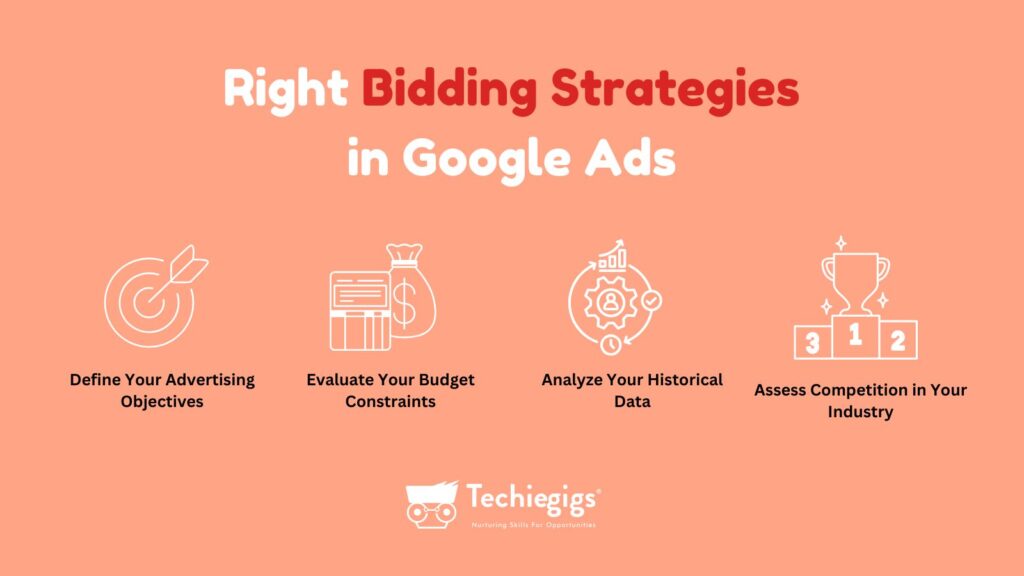
1. Define Your Advertising Objectives:
- If your goal is to increase brand awareness, strategies like Target Impression Share or Maximize Clicks can be effective.
- If your focus is on generating leads or sales, opt for Target CPA or Maximize Conversions.
- For revenue-driven campaigns, Target ROAS or Maximize Conversion Value will be the best fit.
2. Evaluate Your Budget Constraints:
- Automated bidding strategies like Maximize Conversions and Target ROAS may require higher budgets to function effectively.
- Manual CPC or Enhanced CPC (ECPC) can work well for advertisers with tighter budget control.
3. Analyze Your Historical Data:
- If you have a sufficient history of conversions, automated strategies like Target CPA or Maximize Conversions can leverage this data for better optimization.
- For new campaigns without conversion history, Manual CPC or Maximize Clicks may be a better starting point.
4. Assess Competition in Your Industry:
- In highly competitive industries, Target Impression Share ensures your ads appear frequently in top search results.
- Target ROAS can help businesses stay profitable while competing in high-cost environments.
5. Consider Your Campaign Type:
- Search Campaigns: Work well with Manual CPC, Enhanced CPC, Target CPA, and Maximize Conversions.
- Display & Video Campaigns: Benefit from Maximize Clicks, Target Impression Share, and Target CPA.
- Shopping Campaigns: Perform best with Target ROAS and Maximize Conversion Value.
6. Monitor and Adjust Regularly:
- No single bidding strategy is a set-and-forget option. Continuously review performance metrics and adjust bidding strategies to align with changing campaign goals and market conditions.
By carefully evaluating these factors, you can select the most effective bidding strategy in Google Ads to achieve your marketing objectives while optimizing your ad spend.
Best Practices for Implementing Bidding Strategy in Google Ads
Implementing an effective bidding strategy in Google Ads requires careful planning and continuous optimization. Here are some best practices to ensure your bidding strategy yields the best possible results:
1. Monitor Performance Regularly:
- Use Google Ads reports to track bid performance.
- Adjust bids based on conversion data and ROI.
- Keep an eye on CPC, conversion rates, and other key metrics.
2. Utilize A/B Testing:
- Test different bidding strategies to find the most effective one.
- Run experiments comparing manual and automated bidding strategies.
- Adjust bids based on A/B test results.
3. Leverage Google Analytics and Conversion Tracking:
- Use Google Analytics to gain insights into user behavior.
- Set up proper conversion tracking to measure campaign success.
- Attribute conversions accurately to different bid strategies.
4. Set Realistic Expectations:
- Avoid setting unattainable CPA or ROAS goals.
- Be patient and allow time for Google’s algorithms to optimize automated strategies.
- Optimize bids based on long-term trends rather than short-term fluctuations.
5. Utilize Bid Adjustments for Better Targeting:
- Adjust bids for different devices, locations, and times of day.
- Use demographic bid adjustments to prioritize high-value audiences.
- Modify bids based on audience intent and behavior.
6. Segment Campaigns by Intent:
- Separate branded and non-branded keyword campaigns for better control.
- Use different bidding strategies for awareness, consideration, and conversion stages.
- Optimize bids for different funnel stages to maximize impact.
7. Ensure Sufficient Budget Allocation:
- Make sure the budget aligns with your bidding strategy.
- Automated strategies like Maximize Conversions and Target ROAS need sufficient budget to perform effectively.
- Avoid budget limitations that can restrict algorithm learning.
8. Keep an Eye on Market Trends and Competition:
- Regularly review industry trends to adjust bids accordingly.
- Monitor competitor ad placements and bidding strategies.
- Use auction insights reports to assess competitive performance.
9. Optimize for Seasonality and External Factors:
- Adjust bids based on seasonal trends (e.g., holidays, peak shopping seasons).
- Plan bid changes in advance for promotional campaigns.
- Monitor how external events impact consumer behavior and ad performance.
10. Combine Smart Bidding with Manual Oversight:
- While automated bidding is efficient, manual oversight ensures the best results.
- Regularly review automated bid strategies to ensure they align with business objectives.
- Fine-tune bidding settings to maximize efficiency while staying within budget.
By following these best practices, you can effectively implement a bidding strategy in Google Ads that maximizes your ROI while ensuring sustainable campaign performance.
Common Pitfalls and How to Avoid Them
Even with the best bidding strategy in Google Ads, advertisers can make mistakes that negatively impact campaign performance. Here are some common pitfalls and how to avoid them:
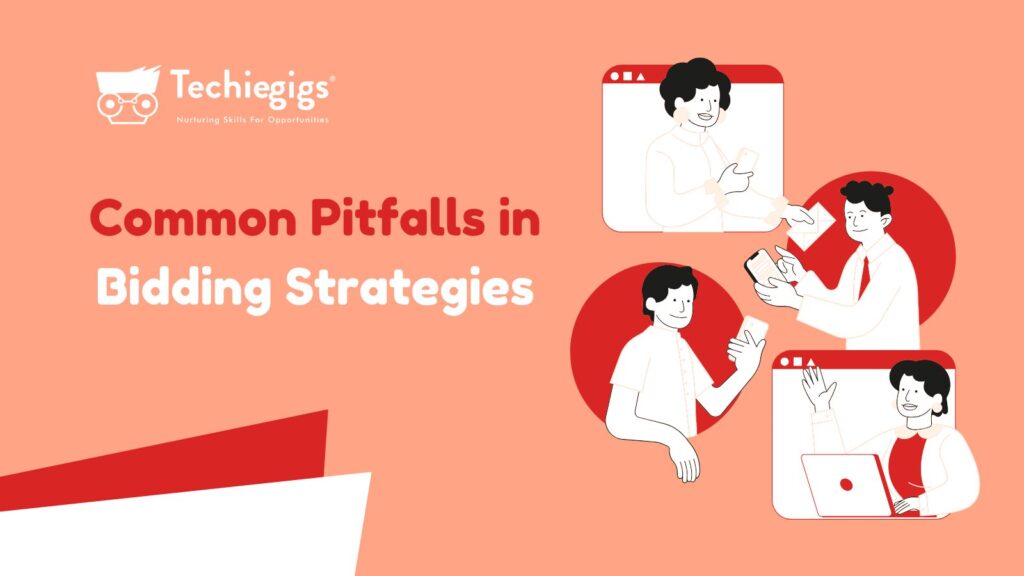
1. Ignoring Conversion Tracking:
- Without proper conversion tracking, it’s impossible to measure the effectiveness of your bidding strategy.
- Ensure that all conversion actions are accurately set up in Google Ads and linked with Google Analytics.
- Regularly audit your conversion tracking setup to check for inconsistencies.
2. Setting Unrealistic Bids:
- Overly aggressive bids can deplete your budget quickly without delivering ROI.
- Start with moderate bid levels and gradually adjust based on performance.
- Use historical campaign data to set realistic CPA and ROAS targets.
3. Not Adjusting for Seasonality:
- Consumer behavior changes during seasonal trends (e.g., holidays, back-to-school, or sales events).
- Adapt bidding strategies for peak shopping seasons by increasing budgets and bids strategically.
- Use automated rules to adjust bids dynamically during specific timeframes.
4. Over-Reliance on Automated Bidding Without Monitoring:
- Automated bidding strategies like Target CPA and Maximize Conversions can be powerful, but they require oversight.
- Regularly review performance and tweak bid adjustments to align with campaign goals.
- Use bid simulations and reports to evaluate effectiveness.
5. Ignoring Mobile and Device Bid Adjustments:
- Users behave differently on mobile versus desktop.
- Use bid modifiers to optimize performance across different devices.
- Analyze device-level performance to ensure effective budget allocation.
6. Focusing Solely on Clicks Instead of Quality Traffic:
- High click volume doesn’t always equate to high conversions.
- Consider metrics like conversion rate and return on ad spend (ROAS) when optimizing bids.
- Use negative keywords to refine audience targeting and improve traffic quality.
7. Lack of A/B Testing for Different Bidding Strategies:
- What works for one campaign may not work for another.
- Run controlled experiments with different bidding strategies to see which yields the best results.
- Compare performance across time periods before finalizing a strategy.
By avoiding these common mistakes and implementing proactive adjustments, advertisers can make their bidding strategy in Google Ads more effective and cost-efficient.
Conclusion
Selecting the right bidding strategy in Google Ads is essential for maximizing ad performance and achieving your business goals. Whether you prefer manual control or automated optimization, understanding the strengths and weaknesses of each strategy will help you make the best decision.
To ensure success:
- Continuously monitor and refine your bidding strategy.
- Use data-driven insights to make informed bid adjustments.
- Experiment with different strategies to determine the best fit for your campaigns.
- Stay updated with Google’s latest algorithm changes and ad auction trend

